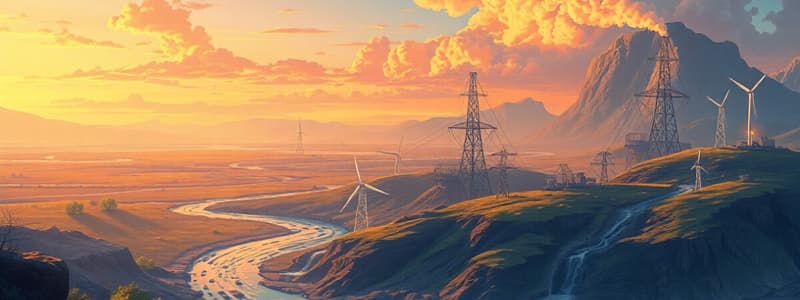Podcast
Questions and Answers
Which mineral is used in plaster and drywall?
Which mineral is used in plaster and drywall?
- Halite
- Bauxite
- Gypsum (correct)
- Quartz
What is common rock salt also known as?
What is common rock salt also known as?
Halite
Which type of fossil fuel is widely used for electricity generation?
Which type of fossil fuel is widely used for electricity generation?
- Coal (correct)
- Natural Gas
- Solar energy
- Oil
Natural gas is used more for electricity generation than coal.
Natural gas is used more for electricity generation than coal.
What energy source is derived from the sun?
What energy source is derived from the sun?
What is the definition of evaporation?
What is the definition of evaporation?
What process involves water falling from the atmosphere?
What process involves water falling from the atmosphere?
Erosion is the process of breaking down rocks into smaller pieces.
Erosion is the process of breaking down rocks into smaller pieces.
What is the primary cause of soil erosion?
What is the primary cause of soil erosion?
The process of breaking down rocks is called ______.
The process of breaking down rocks is called ______.
What gas makes up about 21% of the atmosphere?
What gas makes up about 21% of the atmosphere?
What is the lowest layer of the atmosphere called?
What is the lowest layer of the atmosphere called?
Match the following rock types with their descriptions:
Match the following rock types with their descriptions:
Which of these gases is a minor component of the atmosphere?
Which of these gases is a minor component of the atmosphere?
Flashcards are hidden until you start studying
Study Notes
Earth Resources
- Gypsum: Commonly utilized in plaster and drywall manufacturing.
- Halite: Identified as rock salt, primarily involved in salt production.
- Coal: A major resource for electricity generation.
- Oil: Predominantly used for transportation purposes.
- Natural Gas: Utilized for electricity generation, although to a lesser extent than coal.
- Solar Energy: Harnessed from sunlight, representing a renewable energy source.
- Fossil Fuels: Composed of ancient organic materials, crucial for energy.
- Geothermal Energy: Generated from the Earth’s internal heat.
- Wind Energy: Produced from the movement of air, another renewable energy.
- Hydroelectric Energy: Created from the energy of moving water.
Water Cycle Processes
- Evaporation: The transformation of water into vapor.
- Condensation: The process where water vapor cools and reverts to liquid form.
- Precipitation: Water falls from the atmosphere as rain, snow, etc.
- Transpiration: The release of water vapor into the atmosphere by plants.
Soil Composition and Erosion
- Erosion: The movement of broken-down materials from one location to another.
- Causes of Soil Erosion: Wind, water, and human activities significantly contribute to soil erosion.
- Weathering: The breakdown of rocks into smaller fragments.
- Soil Types:
- Sandy Soil: Drains quickly but has low nutrient retention.
- Loam: An ideal mix of sand, silt, and clay, promoting crop growth.
- Clay: Retains water well but may impede root growth due to density.
- Silt: Nutrient-rich but prone to compaction.
Theories About the Universe
- Steady State Theory: Proposes the universe exists in a constant state without beginning or end.
- Big Bang Theory: Suggests the universe originated from an extremely hot and dense singularity, followed by continuous expansion.
- Encounter Theory: Indicates solar system formation resulted from a close approach between the sun and another star.
- Nebular Theory: Claims the solar system formed from a rotating gaseous and dusty cloud.
- Redshift of Galaxies: Observations show galaxies moving away, supporting the universe's expansion.
- Blue Shift of Stars: Indicates objects moving towards Earth, providing insights contrary to the Big Bang Theory.
Composition of the Atmosphere
- Oxygen: Comprises 21% of the atmosphere, essential for life.
- Nitrogen: Makes up 78% of the atmosphere, necessary for various biological processes.
- Carbon Dioxide: Present in minor quantities, playing a role in the greenhouse effect.
- Methane: Another minor atmospheric component with significant implications on climate change.
Atmospheric Layers
- Troposphere: The lowest atmospheric layer, where weather phenomena occur.
- Stratosphere: Contains the ozone layer, crucial for blocking harmful UV radiation.
- Mesosphere: Located above the stratosphere, meteors typically burn up here.
- Thermosphere: Above the mesosphere, housing satellites and experiencing auroras.
Other Layers & Gases
- Atmosphere: Provides essential gases that support life.
- Hydrosphere: Contains all water resources required for life.
- Geosphere: Comprises Earth’s minerals and habitats.
- Greenhouse Gases: Trap heat and contribute to increasing Earth's surface temperatures.
Rock Types
- Igneous Rock: Formed from cooling and solidification of magma or lava.
- Extrusive Rocks: Created on Earth's surface.
- Intrinsic Rocks: Formed beneath the Earth’s surface.
- Metamorphic Rock: Result from the transformation of existing rocks under heat and pressure.
- Sedimentary Rock: Formed through sediment accumulation, often containing fossils as they form in biological environments.
Important Minerals
- Quartz: Known for its hardness and commonly used in jewelry.
- Diamond: The hardest natural material, extensively used in jewelry.
- Bauxite: The primary ore for obtaining aluminum.
- Hematite: The main ore for iron extraction.
Studying That Suits You
Use AI to generate personalized quizzes and flashcards to suit your learning preferences.




